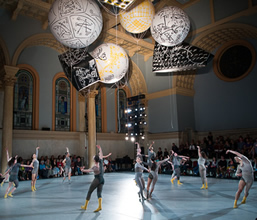From the opening orchestral fugue to the jarring, unresolved concluding chord, Puccini’s Madama Butterfly consistently rates among the four or five most loved operas of all time. Because it is so well known amateur productions of Butterfly run the risk of being compared, perhaps unfairly, to the more professional productions that many audience members have seen. The East Carolina University Opera Theater, of course, is usually the only game of its kind in town for such programs, but that fact does not lessen the need for turning out as polished a staging as possible. Fortunately, in just about every respect, the early March production of Butterfly, sung in Italian without visual translation, had much to commend.
Starting with the focal point of any opera, the voices, the ECU singers who have performed in various choral ensembles consistently show remarkable range and maturity, and the same can be said for the singers in this production, who also included at least one graduate student and one alumnus who returned to share the lead role of Pinkerton.
For the March 5 production, Michelle Ayres sang Butterfly with a big, robust soprano that faltered only on the highest forte notes. In her comfortable range, she showed considerable warmth and expressiveness, and her diction was wonderful. ECU graduate Matthew King returned from California to take on the role of Pinkerton, and his supple tenor was quite nice, though a bit on the thin side when singing against the full orchestral ensemble. While his facial expressions sometimes indicated a near-struggle to reach the upper range of the score, in fact, his voice seemed to move to the highest notes with ease. The two standouts of the evening’s performance, however, were graduate student Eddie Adams as Sharpless and mezzo-soprano Martha Boger as Suzuki. Adams’ commanding baritone was smooth and effortless throughout, and Boger infused her role with considerable authority and, when called for, emotional tenderness.
Puccini’s score, of course, merits all the praise that it gets; it is one of the most beautiful in all of opera literature, with melody following melody following melody. Even the “spoken” segments between arias are tuneful. In this production, the musical highlights were many, but the love duet between Pinkerton and Butterfly that brings Act I to a close was one of the emotional and dramatic high points. So, too, were the flower duet between Butterfly and Suzuki near the end of Act II, Scene I, and the trio of Suzuki, Pinkerton and Sharpless in the climactic Act II, Scene II, following directly after the dramatic exchange involving Pinkerton, Sharpless, and Pinkerton’s wife. The women’s “Humming Chorus” following “Un bel di vedremo” was beautiful. And Ayres sang “Un bel di” well, though the highest forte notes at the end came up short.
The orchestra, a chamber-size ensemble directed by J. Christopher Buddo, performed admirably the entire evening, though in the intimate setting of A.J. Fletcher Recital Hall, the balance occasionally skewed in the orchestra’s favor at the expense of the singers. The solo violin lines (Caroline Cox and Katherine Dennis) were particularly lovely.
The single-setting design of the house and garden, created by ECU alumnus Matthew Scully, was effective, though not elaborate, and the impressionistic tree at center stage was eye-catching. The women’s costumes were beautiful, and one interesting visual aspect of the opera was having Butterfly appear in western dress, with her hair down, for the entire second act, and a large vase in the first act was replaced by a statue of the virgin, in the second act, representing Butterfly’s abandonment of her faith and adoption of Pinkerton’s. The men’s costumes were one drawback, however. Adams, playing the U.S. Consul Sharpless, wore a suit that was a couple of sizes too big. Timothy Messina, as the marriage broker Goro, wore what appeared to be an ill-fitting suit, too, in almost a comic-relief sort of way. But, he also was a Japanese man in Western dress (including a bowler) in 1900 and perhaps his clothing was meant to appear that way.
The ECU Opera Theatre stages two major productions each year, generally from the well-known classical repertoire. Based on this production of Madama Butterfly, audiences in the region need look no further than the ECU campus when seeking fine operatic performances.











